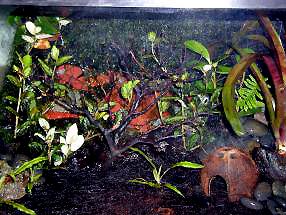
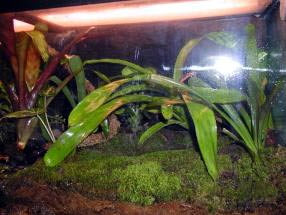
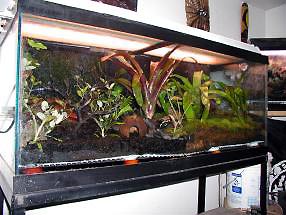
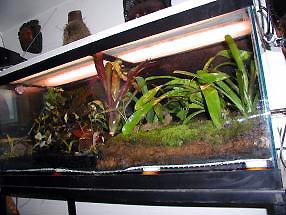
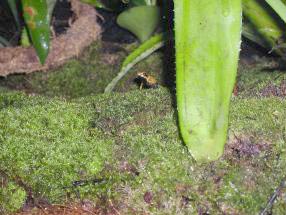
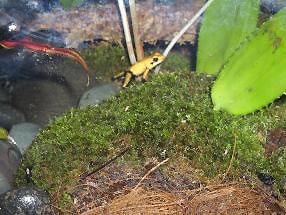
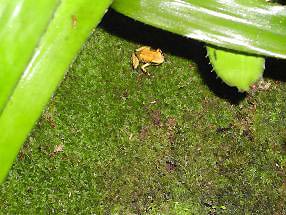
| Wild Sky specialised
frogs,exotic plants, vivarium |







75-Gallon Tank
Brief
Description:
75
gallon Phyllobates tank housing 2 bicolor (red phase) and one mint green
terribilis.
Detailed
Description:
This
is a simple 75-gallon (long) setup for Phyllobates in which I opted to use no
soil substrate at all due to the mess that soil has created in previous
setups. The entire rear wall is
tree fern fiber which, on the left, is kept wet by a water return tube and on
the right is kept mostly dry. The
water return tube is covered by sphagnum secured by silicon glue to disguise it
as a vine. The water flows
down thru the tree fern on the wall and is routed forward by a rubber tab glued
to the glass behind the tree fern fiber (to keep water from flowing behind the
slate) and onto a slate waterfall then through a tree fern floor and into the
reservoir thereby eliminating the lagoon used by most hobbyists (allows for no
chance of drowning and little chance of water leaching or overflowing to my
moss area). Into the waterfall, I inserted cuttings of a vine that's been doing
VERY well in my other tanks but I don't know the name of it. If you can identify it, please email
me. I used java moss to
cover the wet (left) portion of the rear wall and drape over parts of the
waterfall. I've found that java
moss will eventually grow forward and upward into little tree like sprouts
(that look like small evergreens) under good lighting conditions and will also
spread to damp portions of the rear wall.
The
substrate is half tree fern fiber (on left) and on the right, a combination of
tree bark tube halves laid upon each other to create a "rolling"
landscape effect, covered by coco husk and topped with live moss. This way, there's no soil mix to get
waterlogged (and eventually nasty) although it limits plant selections somewhat. For this reason I stuck with epiphytes
with the exception of the black velvet alocasia to the right of my
centerpiece. It's roots are
wrapped with sphagnum moss and coco husk.
The alocasia grows extremely slowly, my guess is the lack of soil but
it's kindof an experiment to see how well it does. Other plants include various bromeliads planted at the base
of the tree fern fiber rear wall (on the right) and in tree fern fiber blocks
secured under the moss bed but above the coco husk layer in the substrate. There are also peperomia obtusifolia
along the rear wall (right side).
On the left side in front of the waterfall I planted earthstars in the
tree fern fiber, also an experiment, as I've always been told that they need
soil. I've been growing an earthstar
like this in another tank for about 8 months and it's been thriving so I hope
for similar results in this project.
There is also an E.T. fern in the rear center, which I planted on lava
rock about 2 weeks ago, but it dropped the few fronds it had. Hopefully, it just needs to adjust and
will re-generate and thrive.
The
tank is inhabited by 2 bicolor (red phase) and one mint green terribilis. I plan to also house aurotania in this
tank when they come available at my local breeder here in Baltimore,
Maryland. There's a misting system
that's not currently working (I mistakenly set it to mist too long and the
motor burned out). There are 2
coco huts and 2 cork bark caves in the enclosure. The cork bark caves (also covered by live moss are built into
the landscape therefore are essentially, underground.
I'll
detail other tanks to be posted soon.
Enjoy!
